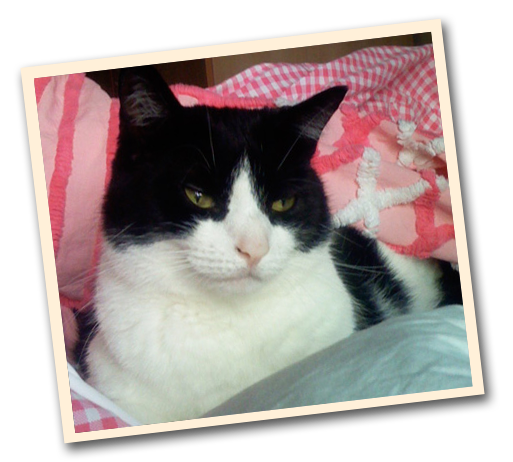

MINNIE ONE was a quirky black-and-white cat who died suddenly a few years ago. The not-so-beloved sister of Mouse and Boops, Minnie hated all felines (including her own siblings) and all but a few humans. Okay, so she was a Mean Girl—sort of. But those whom she liked, she loved, and would smother with affection. Minnie got her well-deserved name because she was a micro version of her oversized brother.
Minnie also defied scientific studies. In the last decade, scientists discovered that cats have lost the function of one of the two genes (found in most other mammals) necessary to taste "sweet." Minnie must have been an evolutionary mutant because she loved ANYTHING with sugar! The sweeter the better! If someone was eating a piece of cake, a bowl of ice cream or any other dessert, he or she had to defend it like a Marine. If not, Minnie would race off at warp speed with her sugary prey. Her favorites? An unguarded bowl of freshly whipped Italian meringue buttercream or royal icing.

MINNIE TWO was my maternal great-grandmother. She was one of 12 children whose parents immigrated to Rochester, New York, from Eastern Europe at the end of the 19th century. Grandma Minnie became a renowned baker, especially for her pastries native to her parents' homeland, such as rugelach, mandelbrodt and hamentashen. Although she died when I was still young, I was lucky enough to have known this exceptional woman. When my family would visit, I spent the entire time in the kitchen with her. I helped crack almonds for the mandelbrodt (the Eastern European version of biscotti), grind poppy seeds for the rugelach and pinch and fold hamentashen dough into little triangles.
As I stood on a stool by her side, I watched as my great-grandmother performed her magic. She never measured or weighed her ingredients; she knew when a batter, filling or dough was just right by the way it looked, felt and smelled. I was in awe as she transformed flour, nuts, seeds and sugar into unimaginable treats. The interminable wait for the first cookies to emerge from the oven was almost unbearable—I was sure I'd be a teenager before the apricot hamentashen turned a golden brown. Looking back, I marvel at how much work everything must have been; she had no electric mixers, no silicone spatulas, no pre-cracked nuts or ground spices. Her tools were a few large ceramic bowls, her trusty wooden spoon and her remarkable hands. My love for baking grew out of that kitchen.
